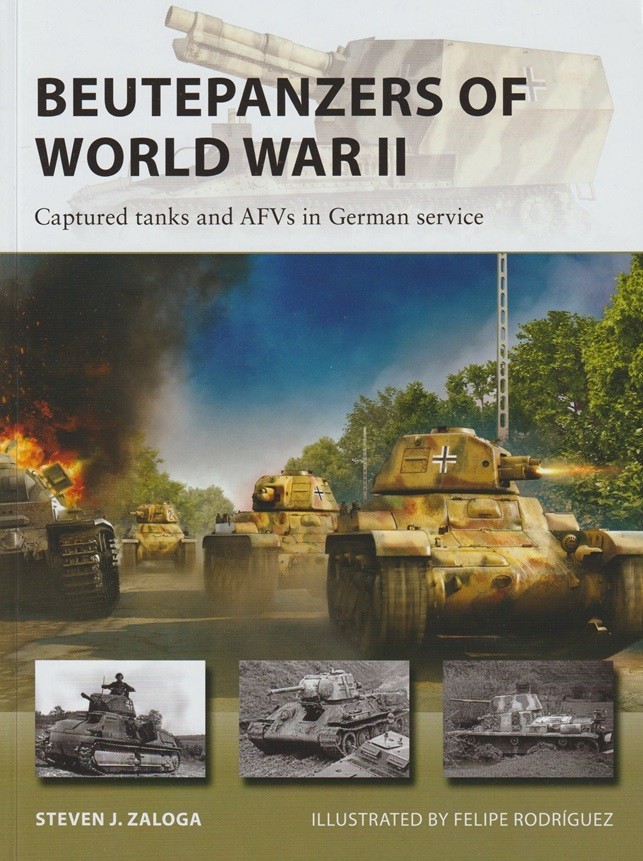
HISTORY:
** In this book, leading armor authority Steven J. Zaloga uncovers one of the least-known aspects of Germany’s World War II tanks: the extensive use of captured “Beutepanzer”. The best came from the fall of France, with the Somua S 35 and Panhard 178 proving popular in German service. Others, such as the antique Renault FT, saw use in anti-partisan missions and airfield protection. Most curious of all were the upgunned, modernized “Becker conversions,” devised by a German officer from an industrial family. These Beutepanzers would play a particularly important role in Normandy in 1944.
He also explains how other war-booty tanks fared” of the many Soviet tanks, captured, most saw little service except to feed Germany’s smelters, while in contrast, northern Italy’s industry continued building tanks and AFVs for Germany after 1943. Tanks captured from Britian, the US, and other Allied armies were generally used on a small, improvised scale.
Illustrated with superb new profiles and rare archive photos, this is a concise guide to an intriguing element of World War II armor. **
** Quoted from the back cover of the book.
THE BOOK:
Osprey Publications has released Beutepanzers of World War II, Captured tanks and AFVs in German Service as Number 332 in their New Vanguard series. It is a soft cover book with 48 pages and is the standard Osprey Publishing size of 7 1/4 x 9 3/4 inches. Included with the text are black and white photographs and color photographs, color illustrations, detailed captions, informational charts and more. It has a 2024 copyright, a publication date of September 26, 2024, and the ISBN is 978-1-4728-5938-9.
THE CONTENTS:
- Introduction
- Polish Tanks and AFVs
- Dutch and Belgian Tanks and AFVs
- French Tanks
- Tank turrets for the Atlantikwall
- French Beutepanzer units
- Becker self-propelled gun conversions on French AFVs
- Other self-propelled gun conversions on French AFVs
- The Beutepanzer Division
- British tanks and AFVS
- Soviet tanks and AFVs
- Italian tanks and AFVs
- German Identification Numbers for Beutepanzers
- Further Reading
- Index
THE TEXT:
Author Steven J. Zaloga has written an excellent history about Germany’s use of captured tanks and armored fighting vehicles, Beutepanzer, during World War II. The author does an excellent job of detailing and discussing, in a well written and easy to follow and understand manner, the use of captured tanks and armored vehicles by the German military and how they were immediately placed into German service or sent to manufacturing locations to be modified to fill specific roles and then returned to combat duty. Zaloga provides very specific information as to the types of tanks and armored vehicles that were captured, their country of origin, the locations and battles in which they were captured, the specific numbers that were captured, the modifications that were made to them, the roles they were placed in such as combat units, base security, anti-partisan duty, static positions, etc. and the military units that they were assigned to. Also detailed is how the vehicles performed, the positive aspects of them as well as the negative aspects of some of them as well as problems they encountered with them such as mechanical failures and poor suspension problems. I personally feel that Author Steven J. Zaloga has done an excellent job of detailing the use of captured tanks and armored vehicles by the German military from the point of their capture, through the modification process they went through up to their losses from combat damage, mechanical issues, abandonment by their crews or capture by enemy forces. In addition to his own words, Steven J. Zaloga has also provided quotes from individuals such as German Generalmajor Hellmuth Reinhardt, who stated that in his opinion “The Beutepanzer (war-booty tanks) did not play a role of any great importance for Germany in World War II”. A portion of the book that I found to be very interesting was the section discussing German Major Alfred Becker, a trained mechanical engineer, who was the primary person responsible for taking obsolete captured British and French vehicles and refurbishing and redesigning them for the German army. These vehicles were known as “Becker Conversions”. Becker had converted the Hotchkiss plant on the outskirts of Paris into a vehicle modification and fabrication center and used the modified vehicles to mobilize German guns, rocket launchers and mortars. Throughout the book where German language is used in the text, the author has included the English translation. A glossary is also included that lists German acronyms and their meaning defined in German and English text. The text in the book is nicely written and well detailed. As I read through the text, I didn’t notice any spelling or grammatical errors. Grammar and spelling might not be an important factor to everyone however it is something that I take notice of and pass on my findings. I feel that if the text is well written then it shows that the author has taken the time to be professional with their writing. Upon finishing the book, I found myself to be well informed on the subject due to the author’s excellent coverage of captured vehicle use by Germany. Anyone wanting to add an excellent reference and history book on Germany’s various uses of captured tanks and armored fighting vehicles, Beutepanzer, during World War II.to their personal library will be pleased with this very informative and interesting book.
THE PHOTOGRAPHS:
A total of 46 black and white photographs are included in this volume. The photographs range from wide angle photographs to close-up detailed photographs. They are a combination of in-action photographs to photographs that have been staged for the photographer. Most of the photographs are well done, however there are some that have an out-of-focus look to them, and some appear to be too dark while others appear too light. All of that is typical for photographs of this time period. Several are stills taken from period films, which would account for the lack of sharpness. One thing that I was appreciative of with the photographs is that a good majority of them are not overused photographs that tend to turn up in numerous other publications of the same subject matter. Author Steven J. Zaloga stuck to the title of the book and chose subject specific photographs and did not include photographs that strayed from the main subject. In addition to photographs of captured armor and vehicles, included are photographs of subjects including modifications made to the captured armor such as rearmament or the addition of weapons, their use in non-traditional roles such as the tanks turrets being used in bunkers such as those on the Atlantic Wall, vehicle paint schemes and military markings, camouflage techniques such as netting and tree branches, battle damage, captured tanks and armored vehicles being examined by allied forces, other non-captured armor and vehicles, German crewmembers with their captured armor and vehicles, Allied military personnel, military uniforms and small arms and other such subjects. The majority, if not all, of the photographs will prove to be excellent reference material for the scale modeler and scratch-builder and anyone interested in the history of Germany’s use of captured tanks and armored fighting vehicles, Beutepanzer, during World War II due to the details they contain.
THE ILLUSTRATIONS:
There are 8 plates featuring a total of 13 color illustrations included in the volume by illustrator Felipe Rodríguez Náñez (aka Felipe Rodna). Accompanying each illustration is a well detailed caption.
The illustrations are all very well done, nicely detailed and are of:
Plate A
Beutepanzer from the 1940 Campaign
1. SpPzWg202(h) (Landsverk 180), 22.Infanterie-Division (Luftlande), Soviet Union, 1941
2. LeFH 16 10.5cm auf Geschützwagen MkVI(e), Batterie 15, Artillerie-Regiment 227, 227.Infanterie-Division, Soviet Union, 1941
Plate B
Beutepanzer Char B
1. 10.5cm leFH 18/3 (Sf) auf Geschützwagen B2(f), I./Artillerie-Regiment 93, 26.Panzer-Division, France, 1942
2. PzKpfw B2 Flamm 740 (f), Stabs-Kompanie, Panzer-Abteilung.205, Le Havre, summer, 1944
Plate C
Becker Conversions
1. 15cm sFH 13 auf Geschützwagen Lorraine, 15.Panzer-Division, Afrikakorps, El Alamein, 1942
2. 7.5cm PaK 40 auf Selbstfahrlafette Souma S307 (f), Panzergrenadier Regiment.125, 21.Panzer Division, Normandy, 1944
Plate D
Beutepanzer Attack at La Fière Bridge
- A color two-page action scene depicting tanks of Panzer-Ersatz-und-Ausbildungs-Abteilung.100 (Panzer Replacement and Training Battalion) under attack from paratroopers of the US 505th and 508th Parachute Infantry Regiments.
Plate E
Soviet Beutepanzer
1. PzKpfw 733 (r) (T-30), 2./Panzer-Regiment 203, Leningrad Front, 1942
2. PzKpfw KV-2 754(r) Panzer-Abt.Z.b.V.66, Operation Herkules, May 1942
Plate F
T-34 in German Service
1. PzKpfw T-34 747 (r), Panzer-Regiment 35, 4.Panzer-Division, Soviet Union, 1943
2. PzKpfw T-34 747 (r), III./SS-Panzer-Regiment.2/SS-Pz.Gren.Div. “Das Reich”
Plate G
Italian Beutepanzer
1. StuG 853 (i) (Semovente M43 da 105/25), Heeres-StuG-Brigade 914, Italy, 1944
2. PzKpfw P40 737 (i), SS-Panzerkompanie.24, 24.Waffen-SS-Gebrigs-Brigade “Karstjäger,” Austria, 1945
THE CAPTIONS:
The captions are well written and explain the accompanying photographs and illustrations in great detail eliminating any doubt as to what is shown. The captions go into very specific detail as to the specific tank or armored vehicle shown and their country of origin, modifications made to them by the German military, the role in which they were placed, weapon types and caliber, vehicle markings, battle damage, individuals shown and their military rank, military unit designations, which vehicles were recaptured by the allies, dates and locations and other such pertinent information. I was impressed by Steven J. Zaloga’s captions as they are very helpful to the reader due to their detailed content as opposed to other captions that I have seen that are very brief and lacking in detail.
INFORMATIONAL CHARTS:
There are 10 informational charts included in this volume and they provide information on:
- Beutepanzers in use by Front, June, 1943
- Beutepanzer strength, April 10, 1945
- French armored vehicles used by Wehrmacht
- German tank turret fortification types
- Panzer turret Ringstand deployment on the Atlantikwall, 1944
- French tanks deployed by Heer, May 31, 1943
- Soviet tank turret Ringstand
- Italian tanks and AFVs in German hands and new production
- Italian Beutepanzers in German service, December 31, 1944
- German identification numbers for Beutepanzers
CONCLUSION:
As with the other Osprey Publishing titles I was impressed with this book. This is a very nice reference book that contains a well written informative text, many subject specific photographs and illustrations, well detailed captions and more, all detailing Germany’s use of captured tanks and armored fighting vehicles, Beutepanzer, during World War II. As with the other Osprey Publishing titles, I have no hesitation recommending this book to others as it will be a welcome addition to one’s personal reference library.
Osprey Publishing also offers Beutepanzers of World War II, Captured tanks and AFVs in German Service as:
Ebook (Epub & Mobi) ISBN: 978-1-4728- 5937-2
and
Ebook (PDF) ISBN: 978-1-4728- 5936-5
Osprey Publishing’s, Beutepanzers of World War II, Captured tanks and AFVs in German Service is also available as a Kindle version through Amazon.
PRICE:
UK £12.99 / US $20.00 / CAN $27.00
This book was provided to me by Osprey Publishing. Please be sure to mention that you saw the book reviewed here on the KitMaker Network when you make your purchase. Thank you.

